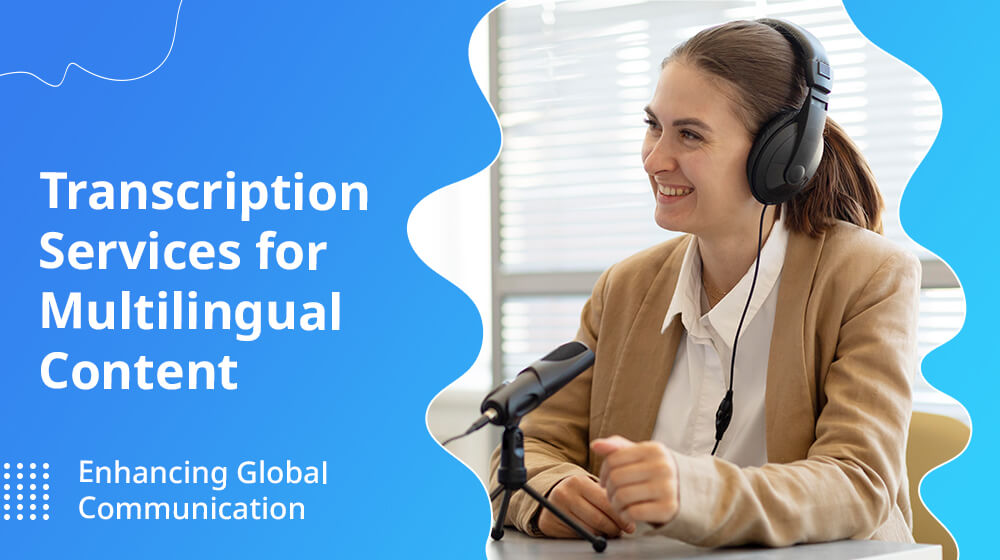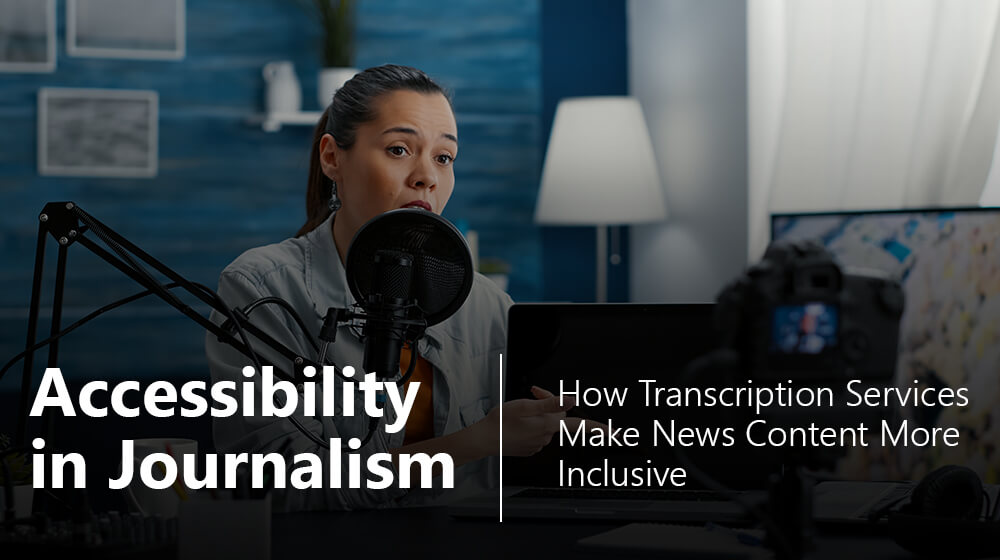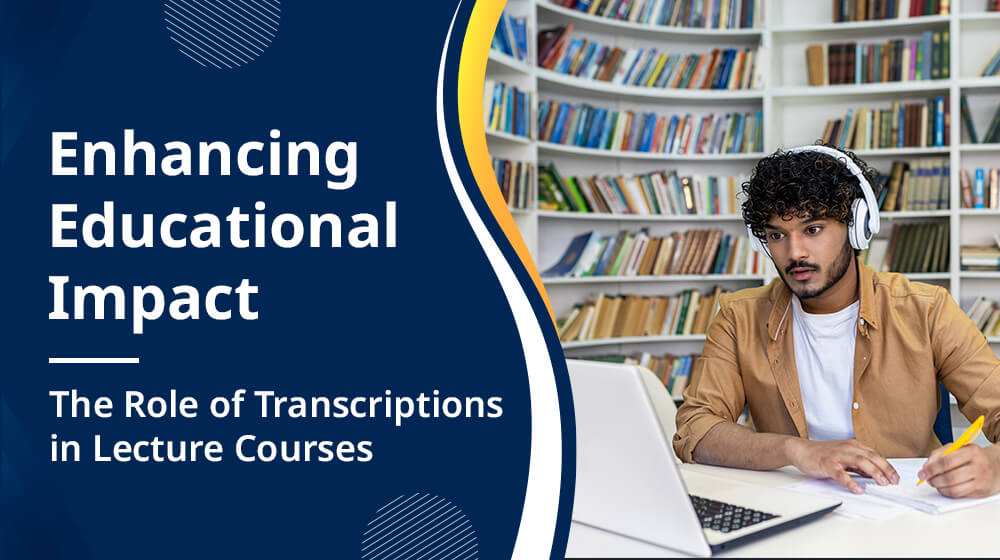With more than 7000 spoken languages and 300 writing systems, multilingual content consumption is at its peak. To ensure that the content is accurately documented and accessible to those with hearing impairments, transcription services are used. Let’s explore transcription services for multilingual content, its importance, challenges, and emerging trends.
Understanding Multilingual Transcription
Transcription services convert spoken content from various languages into written text. Essential for businesses and organizations operating in multiple regions, it ensures effective communication across different languages. It accurately transcribes audio or video content, such as interviews, meetings, or presentations, making the information accessible to a broader audience.
Transcription services for multilingual content are vital for global communication. Whether for legal proceedings, academic research, corporate meetings, or media production, reliable transcription services ensure every word is accurately captured and conveyed, regardless of the original language.
The Importance of Multilingual Transcriptions
Transcription services for multilingual content help in bridging communication gaps in various fields. Here’s how it helps:
1. Enhancing Accessibility and Inclusivity
Multilingual transcriptions make content accessible to non-native speakers and those with hearing impairments. According to the World Health Organization, over 430 million people need rehabilitation for disabling hearing loss. Transcription services for multilingual content ensure equal access to information, fostering inclusivity. Educational institutions can broaden their reach by including multilingual transcriptions, making online courses accessible to students worldwide.
2. Boosting Business Reach and Market Penetration
For global expansion, businesses must communicate across languages. A study by Common Sense Advisory found that 75% of consumers prefer buying in their native language, and 60% avoid English-only websites. Transcription services for multilingual content help localize marketing, product descriptions, and customer service, boosting market penetration and customer satisfaction. This strategy drives sales and builds brand loyalty in international markets.
3. Facilitating International Research and Collaboration
Multilingual transcriptions enable seamless international collaboration in academia and research, breaking language barriers. UNESCO reports over 7 million researchers collaborate globally. Accurate transcription and translation of research findings, interviews, and conferences promote knowledge sharing, crucial in fields like medicine and technology for breakthroughs and advancements.
4. Improving Legal and Compliance Documentation
Multilingual transcriptions ensure accuracy in legal documents, court proceedings, and compliance materials, essential for international legal practices. The American Bar Association notes that language barriers can cause miscommunication and affect case outcomes. Legal Transcription services provide precise documentation, ensuring all parties understand the legal context, regardless of language.
5. Enhancing Media and Entertainment Reach
The media and entertainment industry relies on global audiences. Transcription services for multilingual content of movies, TV shows, and online content enable creators to reach more viewers. Statista reports the global OTT video market will reach $167 billion by 2025. Transcription services provide subtitles, captions, and transcripts in multiple languages, enhancing engagement and accessibility, boosting viewership, and increasing revenue potential from international markets.
Challenges With Multilingual Transcriptions
Transcription services for multilingual content also faces many challenges, including the following:
1. Accuracy and Consistency
Ensuring high accuracy and consistency across different languages can be difficult. Transcribers need to understand cultural nuances, idiomatic expressions, and context to provide precise translations. Inconsistent terminology and varying levels of language proficiency among transcribers can lead to inaccuracies and misunderstandings.
2. Technological Limitations
Automated transcription tools often struggle with multiple languages, dialects, and accents, resulting in errors. While advancements in AI and machine learning have improved these tools, they still lack the human touch required for accurately interpreting complex conversations and context, especially in less common languages.
3. Quality Control
Maintaining a high standard of quality across various languages requires rigorous quality control measures. This involves multiple layers of review, including native speakers, which can be time-consuming and costly. Ensuring that each transcription meets the same quality standards is challenging, especially when dealing with large volumes of content.
4. Resource Availability
Finding skilled transcribers proficient in both the source and target languages, especially for rare or less commonly spoken languages, can be challenging. This scarcity can lead to delays in project completion and higher costs. Additionally, specialized fields like legal or medical transcription require transcribers with domain-specific knowledge, further narrowing the pool of available talent.
5. Cultural Sensitivity
Transcription work often involves sensitive or culturally specific content. Transcribers must be aware of cultural differences and sensitivities to avoid misinterpretations and ensure that the transcribed content respects cultural norms. Missteps in this area can lead to content that is offensive or misleading, damaging the credibility of the transcription service provider.
Emerging Trends
Here are some emerging trends related to transcription services for multilingual content:
1. AI and Machine Learning Integration
The integration of artificial intelligence (AI) and machine learning (ML) is revolutionizing multilingual transcription services. Advanced algorithms like speaker diarization are improving the accuracy and speed of transcriptions, even for complex languages and dialects. AI-driven tools can automatically detect language, convert speech to text, and provide real-time transcriptions. This technology significantly reduces turnaround times and costs, making high-quality transcription services more accessible to a broader audience.
2. Real-Time Transcription and Translation
Real-time transcription and translation services are gaining popularity, especially in live events, webinars, and online meetings. These services provide instant subtitles and translations, enhancing accessibility and engagement for global audiences. The demand for real-time capabilities is driving innovation in both software and hardware solutions, allowing seamless integration with various communication platforms and devices.
3. Voice Recognition and Natural Language Processing (NLP)
Speech recognition and natural language processing (NLP) technologies are becoming more sophisticated, enabling more accurate and context-aware transcriptions. NLP allows transcription tools to understand and process natural language, including idiomatic expressions, slang, and regional dialects. This trend is particularly important for industries like media, entertainment, and customer service, where understanding the context and nuances of spoken language is crucial.
4. Multimodal Transcription Services
Multimodal transcription services combine audio, video, and text inputs to provide comprehensive and context-rich transcriptions. This approach is particularly useful for educational content, training materials, and multimedia presentations, where visual and auditory elements are intertwined. By leveraging multiple data sources, multimodal transcription enhances the accuracy and relevance of the final output, providing a more holistic understanding of the content.
5. Focus on Accessibility and Inclusivity
There is an increasing emphasis on making content accessible and inclusive for all individuals, including those with disabilities.Transcription services for multilingual content are expanding to include not only multiple languages but also different formats, such as braille and sign language interpretations. This trend aligns with global initiatives to promote inclusivity and ensure that everyone, regardless of their linguistic or physical abilities, has equal access to information and opportunities.
Conclusion
Transcription services for multilingual content play a crucial role in enhancing the documentation and distribution of content globally. These services are widely used across various fields, from education and media to legal and healthcare sectors.At ANT Datagain, we understand the importance of high-quality transcription services. We offer tailored solutions for multilingual content to ensure that our clients receive the best possible results.
Contact us today to learn more about how our transcription services can serve your needs and help you reach a global audience.

















